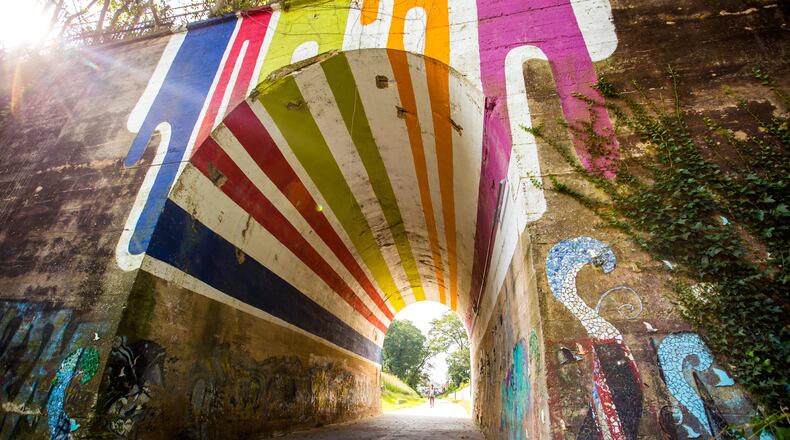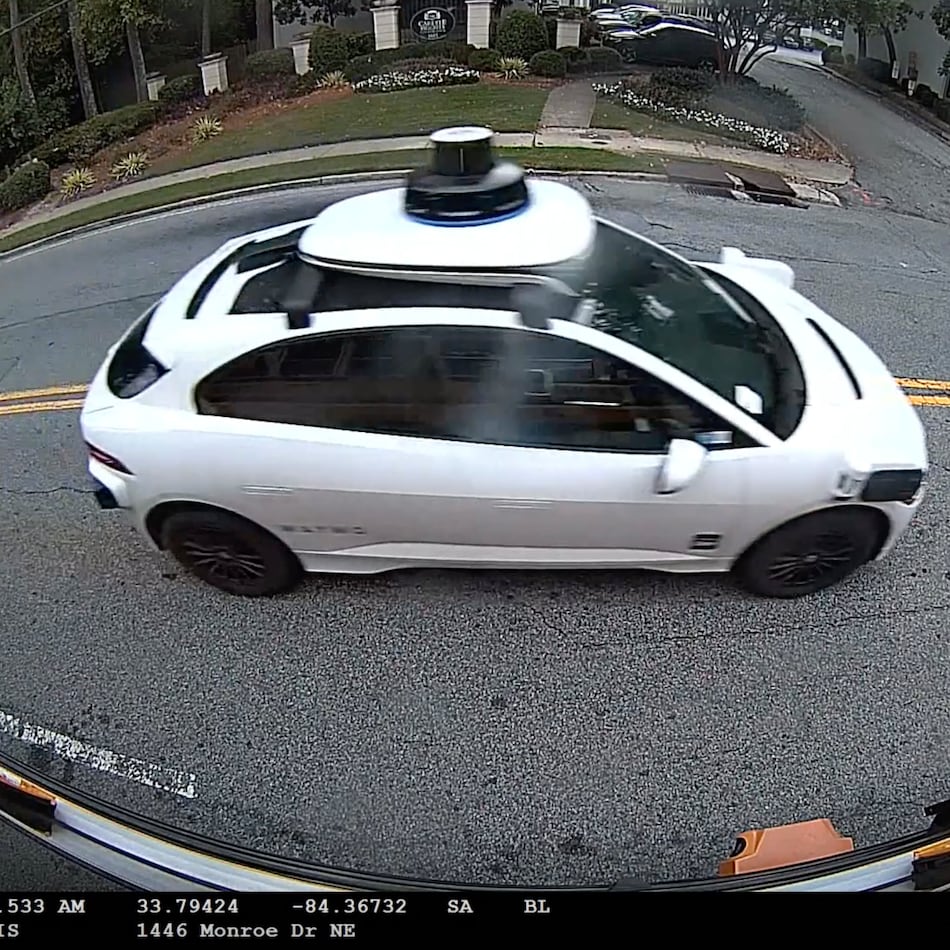Social media apps like Instagram have shaped the way we get out and see the world. Often, these social media posts of visually stunning settings not only draw a like but a desire to go experience that scene in person as well. And no doubt, social media has influenced how—and where—both visitors and locals experience Atlanta.
“The city of Atlanta has done a great job with social media and highlighting areas of the city,” says Stephen Chester, tour guide and sales manager of the Atlanta-based tour company ATL-Cruzers. “Many of the younger travelers are dialed into IG (Instagram) and have requested to see certain sights because of that.”
So, where do you start? More than just landmarks, these five photo favorites show off plenty of Atlanta’s color and character, making the perfect recipe for true Instagram magic.
Jackson Street Bridge
Offering one of the city’s most impressive skyline views, the Jackson Street Bridge is a popular spot for Instagrammers, photographers and couples in pursuit of engagement photos. Plus, equally known for its zombie lure, the bridge attracts AMC’s “The Walking Dead” fans, who recognize the setting as one of the sci-fi show’s most infamous shots.
“Even before the recent impact of the ‘Walking Dead’ television series, this has been one of the most popular photo spots in the city,” says Chester of ATL-Cruzers, which routes many of their electric car, e-bike or Segway tours along the bridge for photo opportunities. “It also is just a great way to show our architecture influences of downtown and talk about people like John Portman and H.J. Russell and their impact on our skyline.”
When taking tours to the bridge, Chester says he also recounts the history of the bridge and the failed Georgia Department of Transportation interchange of the 1960s, which Chester says would have been viewed as a devasting dissection of the city’s historic neighborhoods.
Auburn Avenue
“The most Instagrammed image on Auburn would have to be the mural of Rep. John Lewis at the corner of Jesse Hill, Jr. Drive and Auburn Avenue,” says LeJuano Varnell, executive director Sweet Auburn Works.
With Sweet Auburn Works’ mission to revitalize the historic community, Varnell says public artworks, like the Lewis mural, are huge factors in bringing renewed interests to the street, which is deemed a National Historic Landmark.
Most recently, the economic development organization debuted the “Windows Speak” exhibition, in which massive portraits adorn the windows of the historic Atlanta Life Insurance (ALI) building. The portraits of ALI founder Alonzo Franklin Herndon, ALI president Jesse Hill, Jr. and others tell the story of the company and the leaders who helped to build up the black wealth, community activism and entrepreneurship that earned Sweet Auburn national acclaim. Varnell says to expect more public art projects planned for the famous street, which also calls home to Atlanta sightseeing staples, such as Martin Luther King’s birth home and Big Bethel AME Church.
“When residents, businesses, buildings and the arts are inherited from past generations of a neighborhood or place and preserved for the benefit of future generations, we have created the foundation for a lasting remembrance of a place and the people who call it home,” Varnell says.
Krog Street Tunnel and Wylie Street
Before its social media fame, Chester says you could always rely on the Krog Street tunnel to tape flyers and post information about public meetings, gatherings, festivals and other activities. Now, on any given day, expect to find someone shooting film or photos at the legendary tunnel known for its ever-changing graffiti and full-bodied flare. The drive-through underpass on Krog Street, which also includes two pedestrian walkways, connects the Cabbagetown and Inman Park neighborhoods.
“Initially serving as a gateway to the ‘other side of the tracks,’ it is now linking communities, which were once diverse economically, racially and politically,” says Chester. “Now the murals in the tunnel touch on all of those aspects to try and unite us and bridge that gap.”
From inspirational quotes to displays from both renown street artists and amateur taggers, anything goes here, which is part of the photogenic fun.
Similarly, find more street art by exiting the tunnel onto Wylie Street in Cabbagetown. Here, you’ll find some pretty elaborate commissioned pieces from the state’s top muralists.
Atlanta Rainbow Crosswalk at 10th Street and Piedmont Avenue
From Dallas to Sydney, Australia, more cities around the world are adopting rainbow crosswalks in symbolic shows of support for their LGBTQ communities. Temporarily painted in 2015 for Atlanta Pride week and then permanently instated in 2017, Atlanta was one of the earliest cities to install a rainbow crosswalk. Now an Instagram staple, selfie seekers and couples flock to take pictures on the paved multicolored crossings at the intersection of 10th Street and Piedmont Avenue.
Credit: HANDOUT
Credit: HANDOUT
“The 10th Street and Piedmont intersection has been the epicenter of the LGBTQIA+ movement for many years before the rainbow crosswalks ever existed,” says Robert Sepúlveda Jr., who as the one who brainstormed the Atlanta rainbow crosswalks was instrumental in getting the project completed in 2015.
“The Atlanta Pride parade was established in 1971 and started along 10th Street and Piedmont Avenue. Club Centaur was one of the first non-binary night clubs to open in the area, then the Atlanta Gay Center opened in 1976. As well as [the] Outwrite bookstore, which opened in 1993 and was in operation for over 20 years.”
MORE THINGS TO DO: Podcast: Slutty Vegan
Sepúlveda Jr. is pleased to see the crosswalks being wildly embraced. As the colorful street art attracts Instagrammers, it also draws interests to the historic LGBTQ nucleus while paying homage to the community.
“There was no other logical or respectful place to honor all who came before and all [who] fought for the rights of the LGBTQIA+ community [than] at 10th Street and Piedmont Avenue,” he says.
The Atlanta BeltLine
Though not an official street, the BeltLine is a city-wide (and expanding) multi-use trail filled with several scenes of urban art and Mother Nature’s artistry. Photo-op hunters can find everything from Tiny Doors (the art project that places decorated 7-inch doors in various places around the city) to scenic backdrops at locations like the Virginia Avenue Bridge.
According to Devin Young, project and communications coordinator for the Mayor’s Office of Cultural Affairs, one of the most beloved city-commissioned artworks can be found on the Freedom Park trail section of the BeltLine crossing. The mixed-media installation named ‘Journey to Freedom: Women of the Civil Rights Movement’ showcases photos and illustrations of the Movement’s female heroes.
So even if you’ve not yet explored the BeltLine for recreational pursuits, it’s worth doing for artistic pursuits—and at least if doing it for the ‘Gram.
“Social media has been an incredible tool for expanding the knowledge and appreciation of the pieces in the City’s collection,” says Young. “Prior to the rise of social media, many artworks would sometime exist in isolation, only being experienced by those within its immediate vicinity. However, social media has been vital to exposing these gems to new audiences.”
About the Author
The Latest
Featured











